Wight Conservation - Highland Cattle
Why Highlanders?
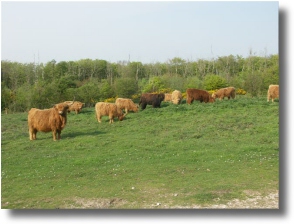
On Mottistone Down |
Highland cattle are the ideal choice for conservation grazing. They are hardy
grazers - they will eat a wide range of vegetation unpalatable to most cattle -,
live out in all seasons and weathers, and have a long breeding life.
Furthermore, they are relatively light in weight and therefore reduce poaching
of the ground.
Highlanders are an essential tool for Wight Conservation. Initially, a few were
purchased to "scrub bash" on Mottistone Down, helping the machinery to clear the
remnants of the destroyed forestry and the secondary growth resulting from the
great October 1987 storm. With their long powerful horns, they fearlessly bash
and clear their way through the thickest of scrub and undergrowth, eating much
as they go. They trample down bracken and brambles. Where they clear, grass
naturally regenerates. In spring they eat the succulent
shoots of weeds we would otherwise have to control.
The Mottistone Fold (herd)
|
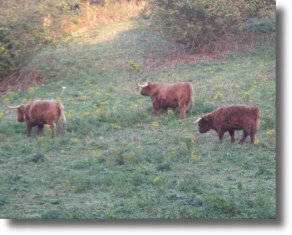
Rowborough Bottom
|
The Mottistone Highland Cattle are now a well known and welcome feature on
much of the Island’s landscape. In summer they can be seen on Mottistone Down,
or perhaps from the bridle path at Rowborough Bottom, clearing and controlling
the fresh vegetation. The restored chalk grassland you will see is much due to
their clearance and grazing. Except for a small group of mature cattle which
stay at Rowborough to continue attacking the scrub, the remainder is removed to
Wroxall for their winter grazing.
|
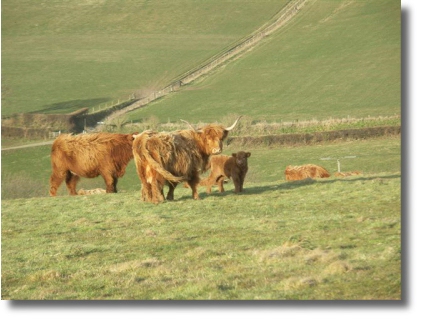
Lucy with heifer calf by Ruairidh of Glengarnock
|
From mid September nearly all the cattle are moved to the Downs at Wroxall where
they graze back the summer’s growth. They can be seen from the public rights of
way on St Martin’s Down and Wroxall Down West. After the hills have been grazed
down to the desired length, usually by early February, the cattle are then moved
to the lower pastures, allowing the spring and summer flora to develop and
flourish. Wroxall is now important for its cowslips, orchids and other valuable
flowering species.
In late winter, as the grass loses its goodness, natural grazing is supplemented
by hard nuts and hay made on the estate, avoiding any "alien" seed imports.
Unless very sick, the cattle are never under cover. Although we have
not applied for organic status, our policy is to follow as many organic
principles as possible.
|
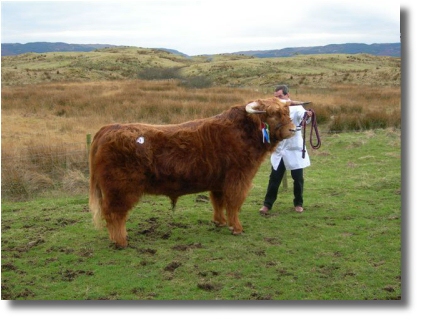
Iasgair of Mottistone
Champion Bull, Oban, 2006
|
The Highlanders’ Year
The cow’s annual cycle begins when the calves are born between the 1st
February and 30th April. On the 1st May the bulls are put in with the cows and
heifers and then removed by the 1st August. Pregnancy lasts 9 months.
Calves are identity-tagged within 24 hours, and before 6 months the young males are castrated and de-horned. De-horning makes them much easier to manage during subsequent handling and transporting. By 9 months all the calves are weaned.
The steers remain in the Wroxall lowland fields until they are sold or sent to a
"finisher" who specialises in Highland meat. In the spring, the young heifers are sent to graze
either at Mottistone Down or Idlecombe, returning again to Wroxall in the
autumn.
Breeding
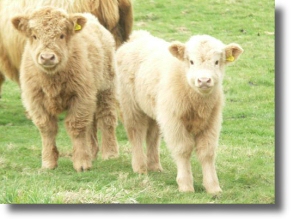 The heifers with good conformation are retained as breeding stock, whilst the
others are sold or kept until slaughter. Heifers are introduced to a stock bull
when three years’ old and should breed annually thereafter up until about 18
years old. The heifers with good conformation are retained as breeding stock, whilst the
others are sold or kept until slaughter. Heifers are introduced to a stock bull
when three years’ old and should breed annually thereafter up until about 18
years old.
Barren cows are selected as "nannies" to the young heifers at Mottistone and
Idlecombe.
Wight Conservation breeds selectively, choosing heifers of good pedigree, size,
and conformation for beef production, with correct heads and horns. Because of
the scale of public access on the estate and the ease of handling, temperament
is another important feature. Our aim is to build up the largest and best
quality fold in the South of England.
Our three stock bulls were purchased from Scotland because we want to retain the breed’s tough hardy characteristics. Ruairdh (Rory) of Glengarnoch (a champion bull at the Royal Highland Show in 1999) was purchased at the Oban Sales in spring 2004, Eoin Mhor of Miungairigh in 2006 and Guag 1st of Culfoich in October 2006. Our homebred Iasgair of Mottistone, which served as a bull in 2005, was the top priced bull at Oban in 2006 after winning the overall Bull Championship for us.
We regularly visit the Oban Sales to top up our stock by purchasing the best blood lines from the hardier and rough-weather Scottish folds. In February 2003, we purchased the overall Female Champion, the three year old heifer Lucy of Balure who has since bred two calves for us. The first, a bull calf, is very closely connected to this year’s Oban champion Bull. In February 2005, we purchased the Champion Female, Iseabal 9th of Carsaig, and in October 2005 we purchased our third Champion Female, Kerrie 2nd of Earn.
Bull calves out of our championship-bred cows will escape castration and be taken from the main fold at weaning. If exceptional, they will be kept by Wight Conservation as stock bulls, but otherwise sold. We are continually seeking to improve the quality of our stock.
We have been fortunate that most of our stock comes from very good blood lines. In time we will
develop our own. In addition to the original unregistered but good
looking cattle purchased by Philip Butchers, our main subsequent purchases have
been from the Balure, Brookfield, Kiln, Ellerdine and The Pheasant Folds. In 2003 and 2006 we purchased groups of heifers from the Kindrochiad Fold on Islay; they contain some of the best and oldest strains in the Stud Book and are the hardiest of stock.
Pedigee Sales
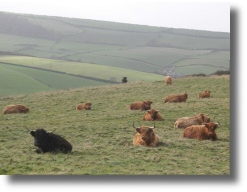 In 2006, 60 cows and heifers were bulled.
Each year we will have on average up to
30 pedigree heifers and cows for sale.
They will be advertised either on Wight
Conservation’s or the Highland Cattle Society’s websites. In 2006, 60 cows and heifers were bulled.
Each year we will have on average up to
30 pedigree heifers and cows for sale.
They will be advertised either on Wight
Conservation’s or the Highland Cattle Society’s websites.
Public Safety
Walkers and others looking at the Highland cattle should realise they are
seldom handled, and although the animals are normally docile, they can be put
into situations where they react badly. Importantly, please remember that cattle
and dogs do not generally mix. When near Highlanders, or any cattle, there are
golden rules to observe:
- Avoid placing yourself between a cow and her calf. Her instinct is to
protect her calf and she could go for you.
- Do not approach and try and touch a Highlander. It is not used to human
handling and could react nervously. Its horns are very big!
- Keep your dog close to heel if you are on a bridle or footpath. All cattle
sometimes run after dogs, and by not using a lead the dog can easily escape
and keep the cattle away from you. Should the cattle rush you with your dog on
a lead, let go of the lead.
- Walk around and not through the cattle.
|